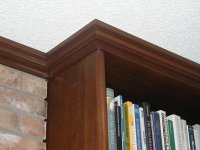We found when banding solid wood banding we milled in the shop, the hot melt adhesive did not adhere well to the wood.
After some trial and error, we ended up priming the strips with PVA glue. Titebond 1 is what we used, thinned about 30% with water. The hotmelt adhered very well to the primed wood. PVA will activate with heat.
If you used one of the water-resistant types as in Titebond 2 or 3 to prime, that may work for your job.
After some trial and error, we ended up priming the strips with PVA glue. Titebond 1 is what we used, thinned about 30% with water. The hotmelt adhered very well to the primed wood. PVA will activate with heat.
If you used one of the water-resistant types as in Titebond 2 or 3 to prime, that may work for your job.

